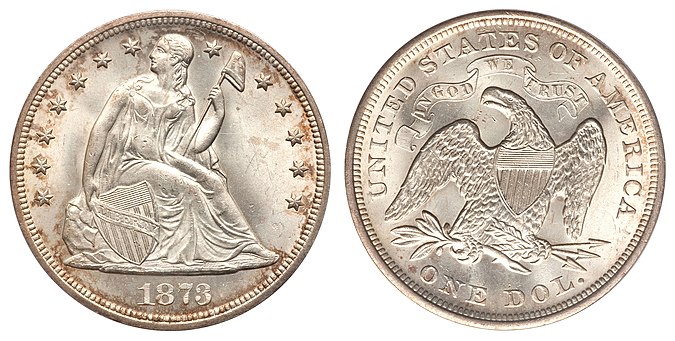The Coinage Act of 1873, often referred to by silver advocates as “The Crime of 1873,” marked a turning point in the monetary history of the United States. By effectively demonetizing silver and transitioning the U.S. toward the gold standard, this legislation ignited a fierce economic and political battle over the role of silver in America’s currency system. The act’s passage reflected global trends, as major economies increasingly favored gold over silver, yet it also had severe domestic consequences—particularly for farmers, miners, and debtors, who relied on silver as a stable store of value. This post explores the causes, effects, and controversies surrounding the Coinage Act of 1873 and how it reshaped the American economy.

1. The U.S. Coinage Act of 1873: What Did It Do?
- Demonetizing Silver
- The Coinage Act removed the silver dollar from the list of coins authorized for minting, effectively ending the free coinage of silver.
- Prior to 1873, Americans could bring silver to the U.S. Mint and have it coined into silver dollars, ensuring its place in circulation. The new law ended this practice, making gold the primary monetary standard.
- Shifting Toward the Gold Standard
- While the U.S. had long operated under a bimetallic standard, the act signaled a move toward a gold-only system.
- It aligned the U.S. with Britain, Germany, and other major economies that had recently adopted gold-backed currencies.
- Creation of New Coinage Standards
- The Act authorized new gold coins and continued the production of subsidiary silver coins (dimes, quarters, and half-dollars) but at a reduced silver content.
- Silver could still be used in small transactions, but it was no longer on equal footing with gold.
2. Why Was Silver Demonetized?
- Global Trends Toward the Gold Standard
- Germany (1871) adopted the gold standard after its victory in the Franco-Prussian War, using war reparations from France to build its gold reserves.
- The Latin Monetary Union (LMU), led by France, struggled to maintain bimetallism as silver’s value declined.
- Britain had long been on the gold standard (since 1821) and dominated global trade.
- To align with international financial trends, the U.S. saw gold as a more stable and globally accepted standard.
- Surging Silver Production Depressed Prices
- Silver mining boomed in the late 19th century, particularly after the discovery of the Comstock Lode (Nevada, 1859).
- The flood of new silver drove prices down, making it less viable as a monetary metal in international trade.
- Policymakers feared that maintaining silver in the monetary system would devalue the currency and cause inflation.
- Banking and Industrial Influence
- Eastern bankers and industrialists supported gold, as it provided greater financial stability and facilitated international trade and investment.
- Many in Congress viewed silver as outdated and believed gold would make the U.S. more competitive in the global economy.
3. The Backlash: Why Was It Called “The Crime of 1873”?
- Impact on Farmers and Debtors
- Farmers in the Midwest and South, who carried significant debt, preferred “free silver” because silver-backed currency would increase the money supply and make debts easier to repay.
- The demonetization of silver meant less money in circulation, leading to deflation—which made debts harder to pay off.
- Outrage from Silver Miners
- Western mining states like Nevada and Colorado suffered as demand for newly mined silver plummeted.
- Miners, who had expected silver to remain a major monetary metal, saw their livelihoods threatened.
- Rise of the Free Silver Movement
- Led by Western politicians, populists, and agrarian activists, the Free Silver Movement called for the return of bimetallism to inflate the currency and ease debt burdens.
- This movement gained traction in the 1890s, culminating in the famous “Cross of Gold” speech by William Jennings Bryan in 1896.
4. The Long-Term Consequences of the Coinage Act
- Deflation and Economic Struggles
- With less silver in circulation, the money supply shrank, contributing to deflation (a general decline in prices).
- Farmers and laborers were hit hardest, as their incomes fell but debts remained the same or even increased in real terms.
- The Rise of the Gold Standard
- Although the Coinage Act of 1873 did not immediately establish a full gold standard, it laid the foundation.
- The Gold Standard Act of 1900 officially confirmed gold as the sole basis for U.S. currency.
- A Political Divide That Lasted Decades
- The controversy over silver vs. gold shaped American politics for the rest of the 19th century, with Populists and Democrats favoring silver and Republicans supporting gold.
- The 1896 and 1900 presidential elections centered on the silver vs. gold debate, with William Jennings Bryan (pro-silver) vs. William McKinley (pro-gold).
Conclusion: The Crime or the Inevitable?
The Coinage Act of 1873 was one of the most consequential monetary decisions in U.S. history. To its supporters, it was a necessary step toward financial stability, aligning America with global gold-based economies. To its critics, it was the “Crime of 1873”, a betrayal of farmers, debtors, and silver miners that deepened economic inequality. Regardless of perspective, the act reshaped the U.S. economy, setting the stage for political and financial battles over the role of silver that would dominate the next several decades.
